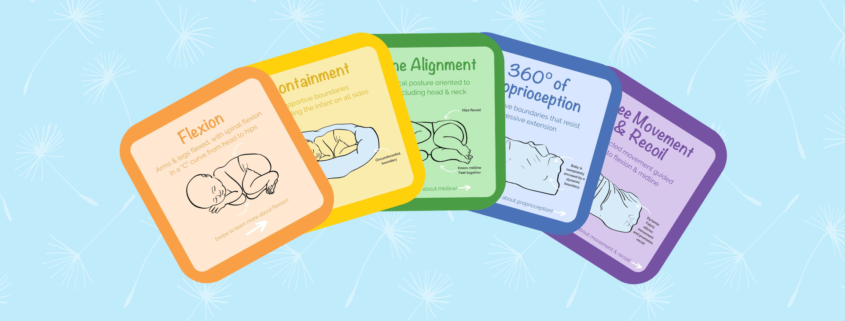5 Key Tenets of Neurodevelopmentally Supportive Positioning™ Deep-Dive
Infant positioning that mimics the intrauterine position positively impacts the healthy development of future motor milestones while having a substantial effect on the neurodevelopment of preterm infants. The DandleLION positioning system promotes the healthy development of the brain and body by more closely mimicking the womb, using the 5 Key Tenets of Neurodevelopmentally Supportive Positioning™.
Each of the 5 Tenets addresses a crucial aspect of intrauterine positioning. These tenets are the foundation of our FREE Positioning Competency Toolkit. We have created carousels for each tenet to provide a deep dive into what each tenet looks like when present, partial, or absent in infant positioning. Check them out below:
Flexion
Flexion in utero is vital to many biologic functions, including swallowing, digestion, joint development, calming, and self-regulation. In the NICU, positioning babies in a flexed posture aids healthy physical development and promotes calm. Flexion can be absent, partial, or complete.
Containment
The immature muscular development of the hospitalized preterm infant prevents them from self-perpetuating flexion, which is typically facilitated by the womb. Containment promotes a flexed posture and provides proprioceptive input, positively influencing the development of the brain and body.
Midline Alignment
Neutral alignment of the head, neck, and extremities along the midline promotes symmetrical musculoskeletal development, self-regulation, and calming.
360º of Proprioception
Proprioceptive input allows the infant to form neuronal connections that establish, to the developing brain, where the body lies in space. During gestation, the uterus encases the baby, providing proprioceptive feedback to the infant regardless of the way the infant moves or stretches.
In the NICU, proprioceptive input can be provided at varying degrees:
- Absent or misplaced, with boundaries touching the baby but not in a way that provides proprioceptive feedback
- Some proprioceptive input can be provided by boundaries around only the head or feet
- Or ideally, 360 degrees of proprioception encases the baby, ensuring a feedback loop is provided to the baby with every movement
Free Movement & Recoil
The uterus allows for unrestricted movement and developmentally appropriate stimulation. Despite being an enclosed space with defined boundaries, there is freedom of movement that facilitates the development of proprioception. Using tools that provide gentle but dynamic resistance, regardless of the degree or direction of extremity extension, is essential to allowing the baby to move freely within the positioner while providing recoil to a flexed posture.
- In the first example, a tightly swaddled hospital blanket does not allow for free movement and does not provide recoil
- A simple positioning nest can allow free movement and may provide some recoil of the lower extremities, but the unsecured straps are unable to facilitate a return to flexion if they are loosened with startling
- The ideal positioning support encircles the baby in a stretchy, responsive fabric covering that allows free movement and provides recoil, while promoting flexion, containment, and midline alignment and providing proprioceptive input
Learn more about how the Positioning Competency Toolkit can be utilized for your clinical practice by checking out our blog post or by downloading the Toolkit.






















